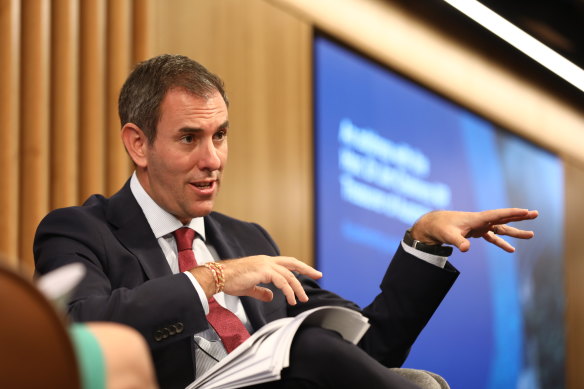The COVID-19 pandemic is expected to cost Australia nearly half a million migrants by 2025-26, even as new figures confirm the overseas intake is finally climbing back to levels last seen before the nation’s borders were shut.
Data from the federal government’s annual population report shows net overseas migration is on track to reach the pre-pandemic trend of 235,000 people on average annually by the middle of the year, buoyed by the return of international students from India and China.
Treasurer Jim Chalmers said the government welcomed the rebound in overseas migration. Credit:Dominic Lorrimer
Overseas migration fell to a record low in 2020-21 as travel restrictions contributed to a net loss of 85,000 people.
The figures were contained in an excerpt of the report, which was prepared by the Centre for Population and will be released in full on Friday.
The data projects that COVID-19’s full hit to cumulative net overseas migration between 2019-20 and 2025-26 will total 473,000 people – roughly the population of Canberra.
But it also shows the $40 billion international education industry is bouncing back. The number of overseas students in the country rose by 122,000 from December 2021 to October 2022 and is projected to stay at pre-pandemic levels.
By mid-October 2022, the number of Chinese students had risen by 90 per cent, or 36,000, compared to the previous December.
Treasurer Jim Chalmers said the government welcomed the rebound in overseas migration on top of figures on Sunday that showed the nation’s fertility rate has bounced back to pre-pandemic levels of 1.66 births per woman.
While migration is recovering, the fertility rate is projected to continue to fall over the long term, contributing to Australia’s ageing population, which Chalmers said posed a challenge to the economy. The falling birth rate means the median age of Australians would rise from 38.2 in 2021 to 42.8 by 2060.
“It is a good thing to see that fertility rate edge upwards,” he said on Monday. “But we are still ageing as a population and as a society and so we need to make sure that we’ve got the workforce to support our society as it changes.”
The report projected Australia’s population would hit 39.2 million by 2060 and natural population would contribute one-quarter of the growth, with the rest driven by overseas migration.
The ageing population increases the risk of workforce shortages and Chalmers said the migration intake could help, but it’s “not the only answer”.
“As the economy recovers from the worst of the pandemic, crippling skills and labour shortages are holding our businesses and our economy back,” he said.
The Albanese government has raised the skilled migration intake from 160,000 to 195,000 and is investing more in skills training while Home Affairs Minister Clare O’Neil announced a review of the migration system in September last year, with a final report due in February.
Chalmers has also committed Treasury to complete an employment white paper by September.
“Australia’s migration settings need to be sustainable, serve Australia’s national interest, and not be a substitute for training and building the capacity of our domestic workforce,” he said on Monday.
Cut through the noise of federal politics with news, views and expert analysis from Jacqueline Maley. Subscribers can sign up to our weekly Inside Politics newsletter here.
Most Viewed in Politics
From our partners
Source: Read Full Article
